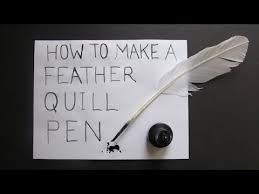The difference between pigment and color: dye is water-soluble and pigment is not. As a result, inks do not have good lightfastness.
Difference ink - paint
In the strict sense, ink is a (colloidal) solution of dyes, and paint a spread with pigments. Paint protects and covers the surface. Ink draws in (but does not protect). Ink is a very liquid colorant for writing or printing.
East Indian ink is a very light-fast, deep-black ink that consists of pure carbon (soot) in water. No binder (like gum arabic) is needed to bind the particles insoluble to the paper and to each other after drying.
Traditionally, this ink contains a gum component in the blocks that were rubbed with water on a rubbing stone.
Other inks are made by a reaction of tannic acid (e.g. from gallops) with a metal salt (iron (II) sulphate or copper (II) sulphate). The color only occurs when the ink has been exposed to the air. That is why e.g. sepia that was taken from the ink bag of the cuttlefish was added.
Arabic gum is resinous and is extracted from the bark of Acacia trees. The gum is soluble in water and therefore water color in which it is used is not waterproof.
Shellac is extracted from a separation of the lacquer shell louse (a tree louse), it dries water-proof so that drawing ink is water-resistant.
Oak gall
Oak gall is a round ball that sits just below the surface of the leaf. It is a kind of overgrowth of the leaf where the oak gall wasp (Cynips quercusfolii) has laid a larva in the leaf. The tree makes as reaction a (little) sphere around the intruder. (All galls are a defense of a plant against a threat by an organism: fungus, bacteria, insect).
 These galls (also oak apple or gallnuts), contain tannic acid, with which you can make ink. Ink is dissolved dye for writing or printing. Take a pot and put some cut oak apples and a few rusty nails in some water. (There may also vinegar in). Let this three or four days, and you have ink water. After writing the ink becomes darker over time.
These galls (also oak apple or gallnuts), contain tannic acid, with which you can make ink. Ink is dissolved dye for writing or printing. Take a pot and put some cut oak apples and a few rusty nails in some water. (There may also vinegar in). Let this three or four days, and you have ink water. After writing the ink becomes darker over time.
You can also make ink from walnuts (see <Stain>).
Soot boiling with water and filtering gives brown ink.
Ink was marketed in powder form. China ink: iron sulfur + sap of the lacquer tree; Egyptian black: soot + gum Arabic, red: red ocher (cinnabar) or red mercury sulfide.
A pen can be cut from suitable cane or (one of the five largest) goose feather (or of swans, or turkey). Are you right-handed, take a pen from the left wing. Try how she lies best in the hand. Draw the top, so that you can make a longitudinal cut in it. But first cut transverse at the back an angle pointed away. Insert the tip first for a few seconds in boiling water to cut easier. You may burn at about 2 cm from the tip with a hot pin a hole to stop the incision. You may cut the flag partially or completely. Clean the inside a bit. To write you baptism your pen every time in the ink. Do not take too much because you make stains. Do not press too hard.
You can also make a brush with the large shaft of a feather. Cut a piece of the narrower upper part of a spring and pull it through the larger hollow shaft so that the beards form the hairs of the brush.
How do you know you ran out of invisible ink?
A drop of ink can put millions of thinking. (Lord Byron)
